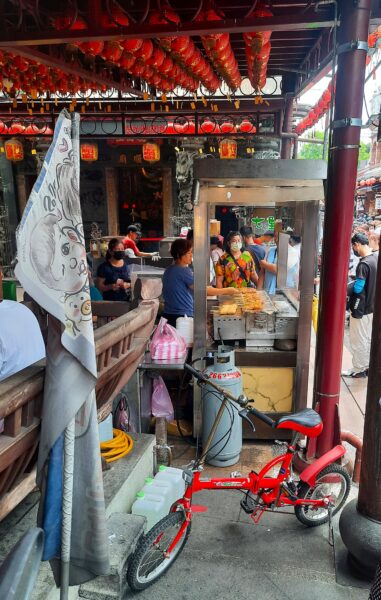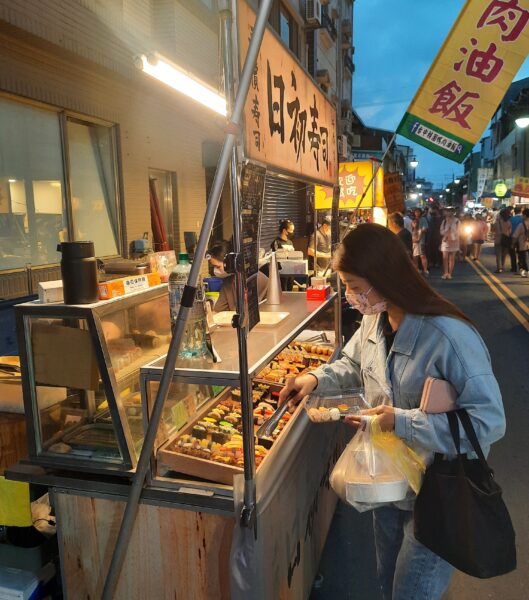
A street food vendor on Shenkeng Old Street, New Taipei
Wherever you begin your tour of Taiwan, you can’t help but notice the vast number of street vendors in urban areas. Even in little towns with just a few thousand residents, you can expect to find stalls selling tasty snacks, drinks, and other inexpensive items. This is one reason travellers who opt to cycle or drive themselves don’t need to carry much in the way of supplies.
Street food is without doubt one of Taiwan’s major attractions. The island’s night markets — be they famous and sprawling affairs like Raohe and Ningxia in Taipei or a single row of hawkers in an obscure township — are more than just places for cheap eats and people watching. They’re a cultural institution. Locals come to play games of skill or luck, buy knickknacks and cheap accessories, and satisfy their cravings for something sweet, something savoury, or something that’s been deep fried.
We at Life of Taiwan know that people’s tastes and dietary routines vary hugely, so we never insist on anything being a ‘must eat’. But here are some easy-to-find Taiwan street food dishes that might appeal to you…
Vegetarian-friendly nibbles
Stinky Tofu (臭豆腐) If you’re a fan of powerfully pungent cheeses, you might well say this snack isn’t especially malodourous. In its most common form, cubes of fermented tofu are deep-fried until they’re crispy on the outside yet soft inside, then served piping hot. (Wait a moment before tucking in, so you don’t burn your mouth.) It’s typically served with pickled cabbage and drizzled with a sweet-and-spicy sauce. If you try and enjoy the deep-fried version consider moving on to steamed stinky tofu, stinky tofu that’s been simmered in a an oily-spicy broth (often with cubes of pigs’ blood), or charcoal-roasted stinky tofu skewers. Perhaps the best place in all of Taiwan to try these delights is Shenkeng, a small town just outside Taipei. It’s truly a mecca for those who adore stinky tofu.
Sweet Potato Balls (地瓜球) Taiwanese have a complicated relationship with Ipomoea batatas. Some older people associate it with poverty because, a couple of generations ago, those who couldn’t afford rice filled their bellies with sweet potato porridge. Households that were a little better off added chunks of sweet potato to rice to eke out expensive grain. More recently, however, the health-conscious have embraced it as a low-calorie, high-fibre way of getting plenty of vitamin A. But there’s nothing complex about sweet potato balls: The tubers are mashed, mixed with a bit of sugar and quite a lot of tapioca starch, kneaded into small balls, then fried in oil. Lightly dusted with powdered sugar, these addictive little treats should be eaten while still crispy on the outside.

Buying sushi in a night market
Scallion Pancake (蔥油餅) A flaky, crispy flatbread made from dough which encases chopped scallions, it tastes good plain but most vendors offer to enhance it with an egg or some kind of filling.
Meaty delights
Fried Chicken Cutlet (炸雞排) Often as big as your hand, these juicy cutlets are usually marinated overnight in a blend of soy sauce, rice wine, sugar, onion, and minced garlic. For the coating, some vendors say sweet-potato flour (rather than wheat flour) gives the cutlets a truly Taiwanese flavor. This item should not to be confused with Popcorn Chicken (鹽酥雞), which is small chunks of broiler meat breaded and seasoned with liberal amounts of garlic and five-spice powder before frying.
‘Big Intestine Wrapping Small Intestine’ (大腸包小腸) This inventive name refers to a pork sausage that’s been grilled then placed like a frankfurter in a glutinous-rice ‘bun’. A dash of sauce, some garlic, and maybe some cucumber completes the package.
Gua Bao aka ‘Taiwanese Hamburger’ (刈包) The two main ingredients are a slab of pork belly, braised until it’s melt-in-your-mouth tender, and the flat steamed bread pocket that contains it — but there’s a lot more going on, as you’ll discover when you take a bite. Any gua bao worth its name includes fresh cilantro, pickled mustard greens, and a layer of crushed peanuts. According to a Singaporean food blogger, ‘These three components extend the dimensions and depth of the dish tremendously, making it so much more interesting [than a similar dish in Fujianese cuisine]’.
Pepper Bun (胡椒餅) Wandering through an old neighbourhood like Wanhua in Taipei, you may come across a cylindrical clay oven (a bit like a tandoor) out on the pavement or under an awning. These are used to bake savoury buns typically filled with a juicy mixture of spiced pork and spring onions. When done right just, the outside is golden brown and crispy yet the dough remains soft and chewy. This is considered a ‘mainlander’ food, i.e. a delicacy that was brought to Taiwan by refugees who fled to the island around the time of Chiang Kai-shek’s retreat in late 1949. Some vendors sell a beef version.

Oyster omelettes in a Tainan night market
Tasting the tides: Seafood snacks
Oyster Omelette (蚵仔煎): A true night market staple — and a food item you can be sure you’ll see in sea-adjacent tourist destinations like Anping and Lukang — this delicacy combines fresh, plump oysters, eggs mixed with starch, and leafy greens. A dollop of a sweet-and-spicy sauce nicely balances out the brininess of the oysters.
Oyster Vermicelli (蚵仔麵線) Traditionally a breakfast food and usually known by its name in the Taiwanese language, o-ah mee sua, this satisfying dish features ultra-thin wheat flour noodles in a thick savoury broth. Sometimes the oysters are replaced by pig intestines.
Crispy Grilled Squid (烤魷魚) Best cooked whole over a charcoal fire, but served chopped into pieces after reheating, this snack is quite salty and very tasty. Many vendors will ask which condiment is preferred, typical options including: pepper and salt; cumin; powdered seaweed; or spicy powder.
Setting foot in a Taiwanese night market for the first time may seem daunting. So many people (especially at the weekend, especially in Taipei)! So many sights and sounds, so many alluring smells! Because almost everything is labelled in Chinese only you may prefer to visit accompanied by an experienced guide who can tell you what you’re about to eat and confirm that it doesn’t contain anything which goes against your religion or provokes your allergies. We at Life of Taiwan have decades of knowledge and a deep love for the island. We’re always happy to share the highlights with curious travellers, whether they’re here for four days or a fortnight. Contact us today to begin planning the Taiwan private guided tour of a lifetime.
